2014 NISSAN QASHQAI warning
[x] Cancel search: warningPage 35 of 338
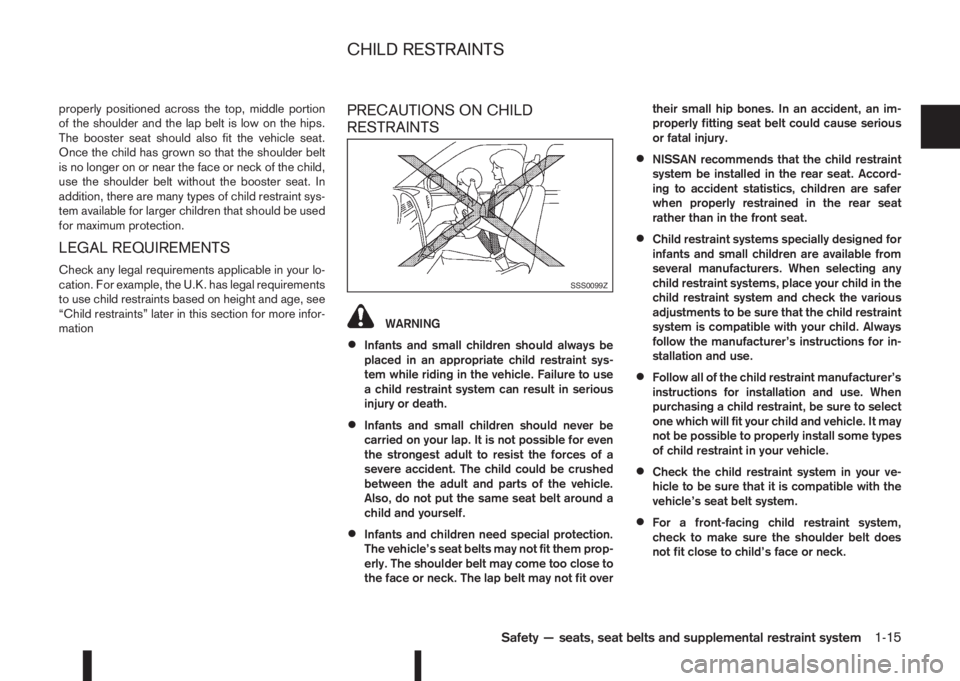
properly positioned across the top, middle portion
of the shoulder and the lap belt is low on the hips.
The booster seat should also fit the vehicle seat.
Once the child has grown so that the shoulder belt
is no longer on or near the face or neck of the child,
use the shoulder belt without the booster seat. In
addition, there are many types of child restraint sys-
tem available for larger children that should be used
for maximum protection.
LEGAL REQUIREMENTS
Check any legal requirements applicable in your lo-
cation. For example, the U.K. has legal requirements
to use child restraints based on height and age, see
“Child restraints” later in this section for more infor-
mation
PRECAUTIONS ON CHILD
RESTRAINTS
WARNING
•Infants and small children should always be
placed in an appropriate child restraint sys-
tem while riding in the vehicle. Failure to use
a child restraint system can result in serious
injury or death.
•Infants and small children should never be
carried on your lap. It is not possible for even
the strongest adult to resist the forces of a
severe accident. The child could be crushed
between the adult and parts of the vehicle.
Also, do not put the same seat belt around a
child and yourself.
•Infants and children need special protection.
The vehicle’s seat belts may not fit them prop-
erly. The shoulder belt may come too close to
the face or neck. The lap belt may not fit overtheir small hip bones. In an accident, an im-
properly fitting seat belt could cause serious
or fatal injury.
•NISSAN recommends that the child restraint
system be installed in the rear seat. Accord-
ing to accident statistics, children are safer
when properly restrained in the rear seat
rather than in the front seat.
•Child restraint systems specially designed for
infants and small children are available from
several manufacturers. When selecting any
child restraint systems, place your child in the
child restraint system and check the various
adjustments to be sure that the child restraint
system is compatible with your child. Always
follow the manufacturer’s instructions for in-
stallation and use.
•Follow all of the child restraint manufacturer’s
instructions for installation and use. When
purchasing a child restraint, be sure to select
one which will fit your child and vehicle. It may
not be possible to properly install some types
of child restraint in your vehicle.
•Check the child restraint system in your ve-
hicle to be sure that it is compatible with the
vehicle’s seat belt system.
•For a front-facing child restraint system,
check to make sure the shoulder belt does
not fit close to child’s face or neck.
SSS0099Z
CHILD RESTRAINTS
Safety — seats, seat belts and supplemental restraint system1-15
Page 41 of 338
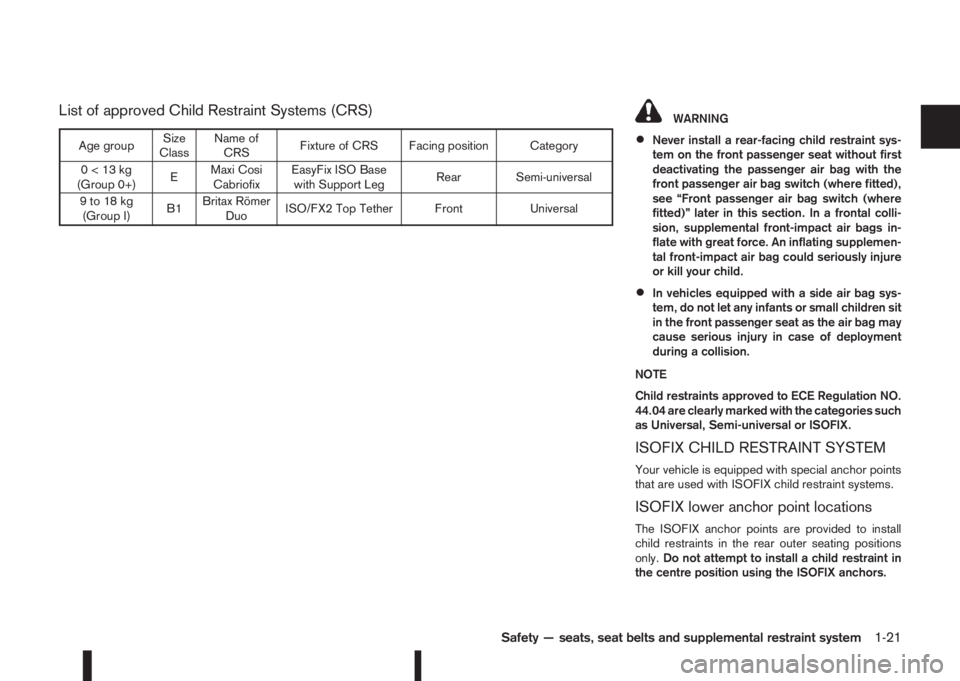
List of approved Child Restraint Systems (CRS)WARNING
•Never install a rear-facing child restraint sys-
tem on the front passenger seat without first
deactivating the passenger air bag with the
front passenger air bag switch (where fitted),
see “Front passenger air bag switch (where
fitted)” later in this section. In a frontal colli-
sion, supplemental front-impact air bags in-
flate with great force. An inflating supplemen-
tal front-impact air bag could seriously injure
or kill your child.
•In vehicles equipped with a side air bag sys-
tem, do not let any infants or small children sit
in the front passenger seat as the air bag may
cause serious injury in case of deployment
during a collision.
NOTE
Child restraints approved to ECE Regulation NO.
44.04 are clearly marked with the categories such
as Universal, Semi-universal or ISOFIX.
ISOFIX CHILD RESTRAINT SYSTEM
Your vehicle is equipped with special anchor points
that are used with ISOFIX child restraint systems.
ISOFIX lower anchor point locations
The ISOFIX anchor points are provided to install
child restraints in the rear outer seating positions
only.Do not attempt to install a child restraint in
the centre position using the ISOFIX anchors.
Age groupSize
ClassName of
CRSFixture of CRS Facing position Category
0<13kg
(Group 0+)EMaxi Cosi
CabriofixEasyFix ISO Base
with Support LegRear Semi-universal
9to18kg
(Group I)B1Britax Römer
DuoISO/FX2 Top Tether Front Universal
Safety — seats, seat belts and supplemental restraint system1-21
Page 42 of 338
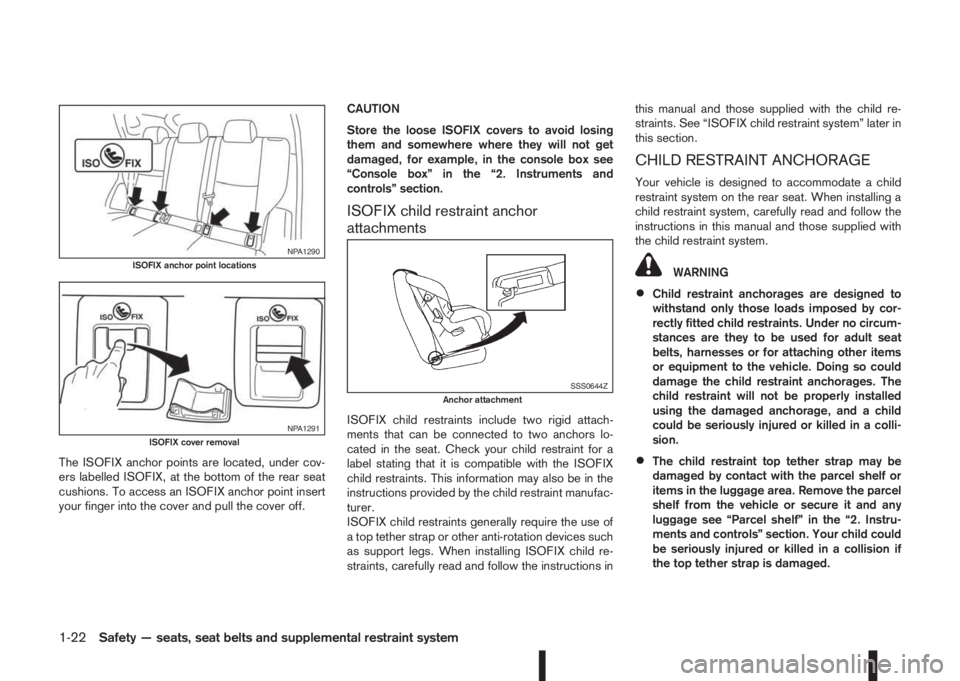
The ISOFIX anchor points are located, under cov-
ers labelled ISOFIX, at the bottom of the rear seat
cushions. To access an ISOFIX anchor point insert
your finger into the cover and pull the cover off.CAUTION
Store the loose ISOFIX covers to avoid losing
them and somewhere where they will not get
damaged, for example, in the console box see
“Console box” in the “2. Instruments and
controls” section.
ISOFIX child restraint anchor
attachments
ISOFIX child restraints include two rigid attach-
ments that can be connected to two anchors lo-
cated in the seat. Check your child restraint for a
label stating that it is compatible with the ISOFIX
child restraints. This information may also be in the
instructions provided by the child restraint manufac-
turer.
ISOFIX child restraints generally require the use of
a top tether strap or other anti-rotation devices such
as support legs. When installing ISOFIX child re-
straints, carefully read and follow the instructions inthis manual and those supplied with the child re-
straints. See “ISOFIX child restraint system” later in
this section.
CHILD RESTRAINT ANCHORAGE
Your vehicle is designed to accommodate a child
restraint system on the rear seat. When installing a
child restraint system, carefully read and follow the
instructions in this manual and those supplied with
the child restraint system.
WARNING
•Child restraint anchorages are designed to
withstand only those loads imposed by cor-
rectly fitted child restraints. Under no circum-
stances are they to be used for adult seat
belts, harnesses or for attaching other items
or equipment to the vehicle. Doing so could
damage the child restraint anchorages. The
child restraint will not be properly installed
using the damaged anchorage, and a child
could be seriously injured or killed in a colli-
sion.
•The child restraint top tether strap may be
damaged by contact with the parcel shelf or
items in the luggage area. Remove the parcel
shelf from the vehicle or secure it and any
luggage see “Parcel shelf” in the “2. Instru-
ments and controls” section. Your child could
be seriously injured or killed in a collision if
the top tether strap is damaged.
NPA1290ISOFIX anchor point locations
NPA1291ISOFIX cover removal
SSS0644ZAnchor attachment
1-22Safety — seats, seat belts and supplemental restraint system
Page 43 of 338
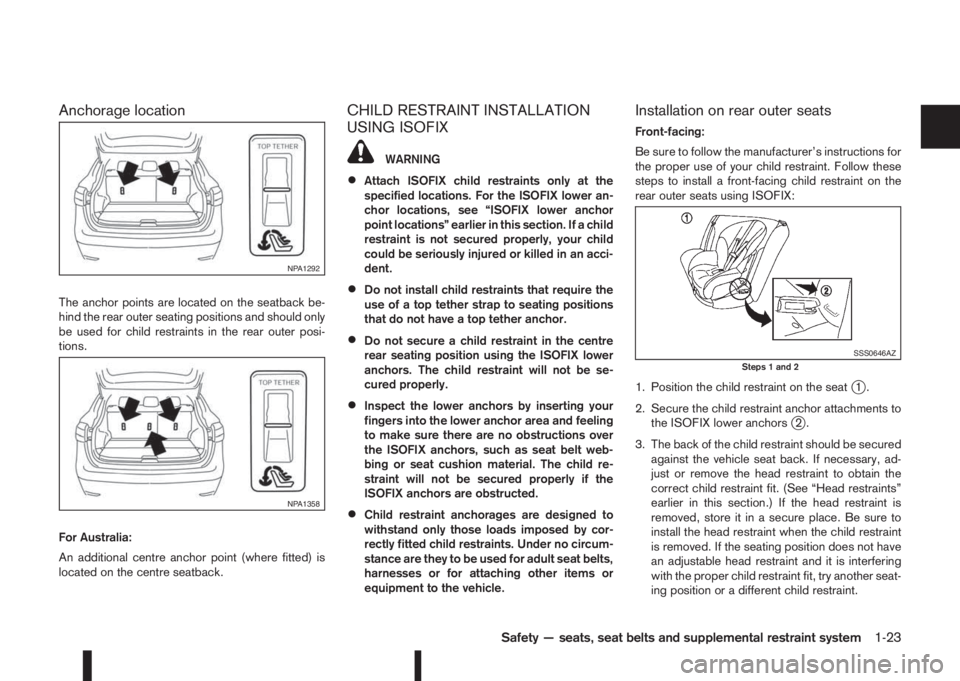
Anchorage location
The anchor points are located on the seatback be-
hind the rear outer seating positions and should only
be used for child restraints in the rear outer posi-
tions.
For Australia:
An additional centre anchor point (where fitted) is
located on the centre seatback.
CHILD RESTRAINT INSTALLATION
USING ISOFIX
WARNING
•Attach ISOFIX child restraints only at the
specified locations. For the ISOFIX lower an-
chor locations, see “ISOFIX lower anchor
point locations” earlier in this section. If a child
restraint is not secured properly, your child
could be seriously injured or killed in an acci-
dent.
•Do not install child restraints that require the
use of a top tether strap to seating positions
that do not have a top tether anchor.
•Do not secure a child restraint in the centre
rear seating position using the ISOFIX lower
anchors. The child restraint will not be se-
cured properly.
•Inspect the lower anchors by inserting your
fingers into the lower anchor area and feeling
to make sure there are no obstructions over
the ISOFIX anchors, such as seat belt web-
bing or seat cushion material. The child re-
straint will not be secured properly if the
ISOFIX anchors are obstructed.
•Child restraint anchorages are designed to
withstand only those loads imposed by cor-
rectly fitted child restraints. Under no circum-
stance are they to be used for adult seat belts,
harnesses or for attaching other items or
equipment to the vehicle.
Installation on rear outer seats
Front-facing:
Be sure to follow the manufacturer’s instructions for
the proper use of your child restraint. Follow these
steps to install a front-facing child restraint on the
rear outer seats using ISOFIX:
1. Position the child restraint on the seat
j1.
2. Secure the child restraint anchor attachments to
the ISOFIX lower anchors
j2.
3. The back of the child restraint should be secured
against the vehicle seat back. If necessary, ad-
just or remove the head restraint to obtain the
correct child restraint fit. (See “Head restraints”
earlier in this section.) If the head restraint is
removed, store it in a secure place. Be sure to
install the head restraint when the child restraint
is removed. If the seating position does not have
an adjustable head restraint and it is interfering
with the proper child restraint fit, try another seat-
ing position or a different child restraint.
NPA1292
NPA1358
SSS0646AZSteps 1 and 2
Safety — seats, seat belts and supplemental restraint system1-23
Page 47 of 338
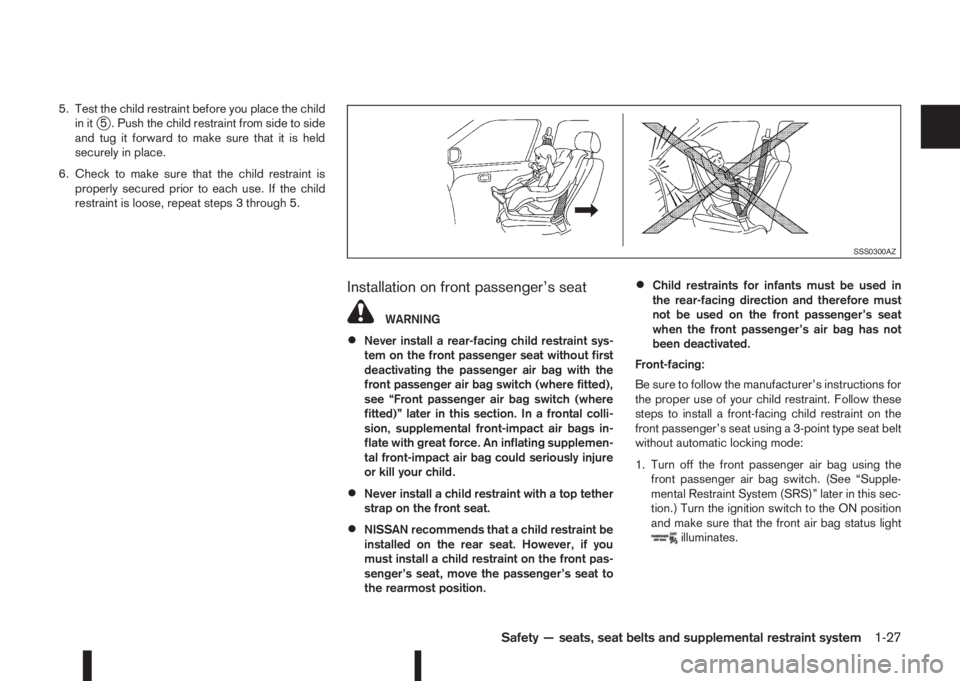
5. Test the child restraint before you place the child
in itj5 . Push the child restraint from side to side
and tug it forward to make sure that it is held
securely in place.
6. Check to make sure that the child restraint is
properly secured prior to each use. If the child
restraint is loose, repeat steps 3 through 5.
Installation on front passenger’s seat
WARNING
•Never install a rear-facing child restraint sys-
tem on the front passenger seat without first
deactivating the passenger air bag with the
front passenger air bag switch (where fitted),
see “Front passenger air bag switch (where
fitted)” later in this section. In a frontal colli-
sion, supplemental front-impact air bags in-
flate with great force. An inflating supplemen-
tal front-impact air bag could seriously injure
or kill your child.
•Never install a child restraint with a top tether
strap on the front seat.
•NISSAN recommends that a child restraint be
installed on the rear seat. However, if you
must install a child restraint on the front pas-
senger’s seat, move the passenger’s seat to
the rearmost position.
•Child restraints for infants must be used in
the rear-facing direction and therefore must
not be used on the front passenger’s seat
when the front passenger’s air bag has not
been deactivated.
Front-facing:
Be sure to follow the manufacturer’s instructions for
the proper use of your child restraint. Follow these
steps to install a front-facing child restraint on the
front passenger’s seat using a 3-point type seat belt
without automatic locking mode:
1. Turn off the front passenger air bag using the
front passenger air bag switch. (See “Supple-
mental Restraint System (SRS)” later in this sec-
tion.) Turn the ignition switch to the ON position
and make sure that the front air bag status light
illuminates.
SSS0300AZ
Safety — seats, seat belts and supplemental restraint system1-27
Page 50 of 338
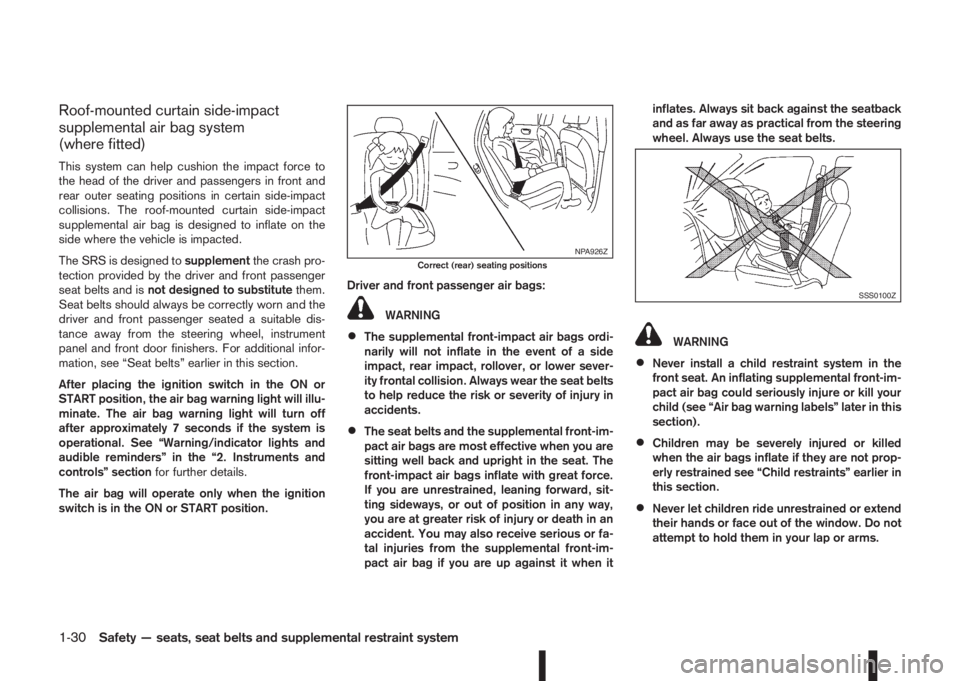
Roof-mounted curtain side-impact
supplemental air bag system
(where fitted)
This system can help cushion the impact force to
the head of the driver and passengers in front and
rear outer seating positions in certain side-impact
collisions. The roof-mounted curtain side-impact
supplemental air bag is designed to inflate on the
side where the vehicle is impacted.
The SRS is designed tosupplementthe crash pro-
tection provided by the driver and front passenger
seat belts and isnot designed to substitutethem.
Seat belts should always be correctly worn and the
driver and front passenger seated a suitable dis-
tance away from the steering wheel, instrument
panel and front door finishers. For additional infor-
mation, see “Seat belts” earlier in this section.
After placing the ignition switch in the ON or
START position, the air bag warning light will illu-
minate. The air bag warning light will turn off
after approximately 7 seconds if the system is
operational. See “Warning/indicator lights and
audible reminders” in the “2. Instruments and
controls” sectionfor further details.
The air bag will operate only when the ignition
switch is in the ON or START position.Driver and front passenger air bags:
WARNING
•The supplemental front-impact air bags ordi-
narily will not inflate in the event of a side
impact, rear impact, rollover, or lower sever-
ity frontal collision. Always wear the seat belts
to help reduce the risk or severity of injury in
accidents.
•The seat belts and the supplemental front-im-
pact air bags are most effective when you are
sitting well back and upright in the seat. The
front-impact air bags inflate with great force.
If you are unrestrained, leaning forward, sit-
ting sideways, or out of position in any way,
you are at greater risk of injury or death in an
accident. You may also receive serious or fa-
tal injuries from the supplemental front-im-
pact air bag if you are up against it when itinflates. Always sit back against the seatback
and as far away as practical from the steering
wheel. Always use the seat belts.
WARNING
•Never install a child restraint system in the
front seat. An inflating supplemental front-im-
pact air bag could seriously injure or kill your
child (see “Air bag warning labels” later in this
section).
•Children may be severely injured or killed
when the air bags inflate if they are not prop-
erly restrained see “Child restraints” earlier in
this section.
•Never let children ride unrestrained or extend
their hands or face out of the window. Do not
attempt to hold them in your lap or arms.
NPA926ZCorrect (rear) seating positions
SSS0100Z
1-30Safety — seats, seat belts and supplemental restraint system
Page 51 of 338
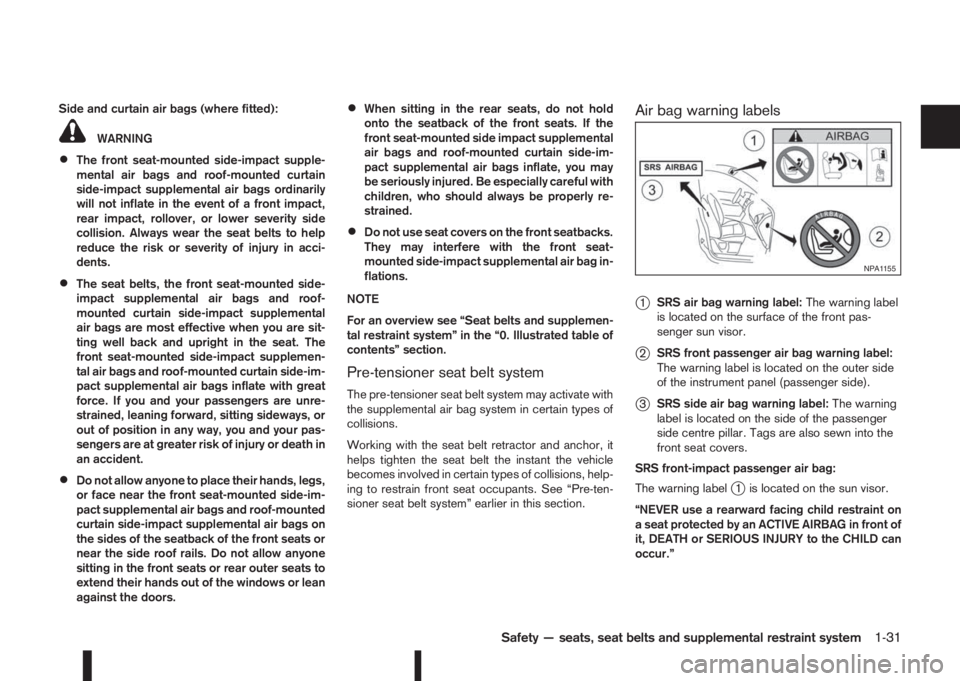
Side and curtain air bags (where fitted):
WARNING
•The front seat-mounted side-impact supple-
mental air bags and roof-mounted curtain
side-impact supplemental air bags ordinarily
will not inflate in the event of a front impact,
rear impact, rollover, or lower severity side
collision. Always wear the seat belts to help
reduce the risk or severity of injury in acci-
dents.
•The seat belts, the front seat-mounted side-
impact supplemental air bags and roof-
mounted curtain side-impact supplemental
air bags are most effective when you are sit-
ting well back and upright in the seat. The
front seat-mounted side-impact supplemen-
tal air bags and roof-mounted curtain side-im-
pact supplemental air bags inflate with great
force. If you and your passengers are unre-
strained, leaning forward, sitting sideways, or
out of position in any way, you and your pas-
sengers are at greater risk of injury or death in
an accident.
•Do not allow anyone to place their hands, legs,
or face near the front seat-mounted side-im-
pact supplemental air bags and roof-mounted
curtain side-impact supplemental air bags on
the sides of the seatback of the front seats or
near the side roof rails. Do not allow anyone
sitting in the front seats or rear outer seats to
extend their hands out of the windows or lean
against the doors.
•When sitting in the rear seats, do not hold
onto the seatback of the front seats. If the
front seat-mounted side impact supplemental
air bags and roof-mounted curtain side-im-
pact supplemental air bags inflate, you may
be seriously injured. Be especially careful with
children, who should always be properly re-
strained.
•Do not use seat covers on the front seatbacks.
They may interfere with the front seat-
mounted side-impact supplemental air bag in-
flations.
NOTE
For an overview see “Seat belts and supplemen-
tal restraint system” in the “0. Illustrated table of
contents” section.
Pre-tensioner seat belt system
The pre-tensioner seat belt system may activate with
the supplemental air bag system in certain types of
collisions.
Working with the seat belt retractor and anchor, it
helps tighten the seat belt the instant the vehicle
becomes involved in certain types of collisions, help-
ing to restrain front seat occupants. See “Pre-ten-
sioner seat belt system” earlier in this section.
Air bag warning labels
j
1SRS air bag warning label:The warning label
is located on the surface of the front pas-
senger sun visor.
j2SRS front passenger air bag warning label:
The warning label is located on the outer side
of the instrument panel (passenger side).
j3SRS side air bag warning label:The warning
label is located on the side of the passenger
side centre pillar. Tags are also sewn into the
front seat covers.
SRS front-impact passenger air bag:
The warning label
j1 is located on the sun visor.
“NEVER use a rearward facing child restraint on
a seat protected by an ACTIVE AIRBAG in front of
it, DEATH or SERIOUS INJURY to the CHILD can
occur.”
NPA1155
Safety — seats, seat belts and supplemental restraint system1-31
Page 52 of 338

The BACK SEAT is the SAFEST place for children
aged 12 and under. Always use seat belts and
child restraints. For maximum safety protection
in all types of crashes, you must always wear
your safety belt. Do not sit or lean unnecessarily
close to the airbag. Do not place any objects over
the airbag or between the airbag and yourself. If
the airbag warning light stays on or is flashing
when the ignition switch is placed in the ON posi-
tion, go to a NISSAN dealer or qualified work-
shop. Airbags can only be removed or disposed
of by a NISSAN dealer or qualified workshop.
Be sure to read the “AIRBAG LABEL” description
at the end of this manual.
In vehicles equipped with a front-impact passenger
air bag system, use a rear-facing child restraint sys-
tem only on the rear seats.
When installing a child restraint system in your ve-
hicle, always follow the child restraint system manu-
facturer’s instructions for installation. For informa-
tion, see “Child restraints” earlier in this section.SRS air bag warning light
The SRS air bag warning light, displayingin
the instrument panel, monitors the circuits of the
supplemental front-impact air bag, front seat-
mounted side-impact supplemental air bag (where
fitted), supplemental curtain side-impact air bags
(where fitted), and pre-tensioner seat belt systems.
The circuits monitored by the SRS air bag warning
light are the diagnosis sensor unit, crash zone sen-
sor, satellite sensors, front impact air bag modules,
front seat-mounted side-impact supplemental air
bag modules (where fitted), roof-mounted curtain
side-impact supplemental air bag modules (where
fitted), pre-tensioner seat belt systems, and all re-
lated wiring.
After placing the ignition switch in the ON or
START position, the supplemental air bag warn-
ing light illuminates. The air bag warning light will
turn off after approximately 7 seconds if the sys-
tem is operational.Have the air bag systems and/or pre-tensioner seat
belt systems serviced at the nearest NISSAN dealer
or qualified workshop if any of the following condi-
tions occur:
•The SRS air bag warning light remains on after
approximately 7 seconds.
•The SRS air bag warning light flashes intermit-
tently.
•The SRS air bag warning light does not illumi-
nate at all.
Under these conditions, the air bag systems and/or
pre-tensioner seat belt systems may not operate
properly. They must be checked and repaired. Con-
tact a NISSAN dealer or qualified workshop imme-
diately.
NPA1295
1-32Safety — seats, seat belts and supplemental restraint system